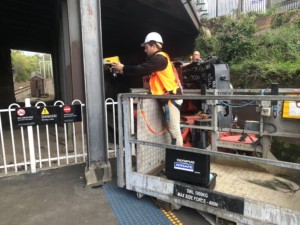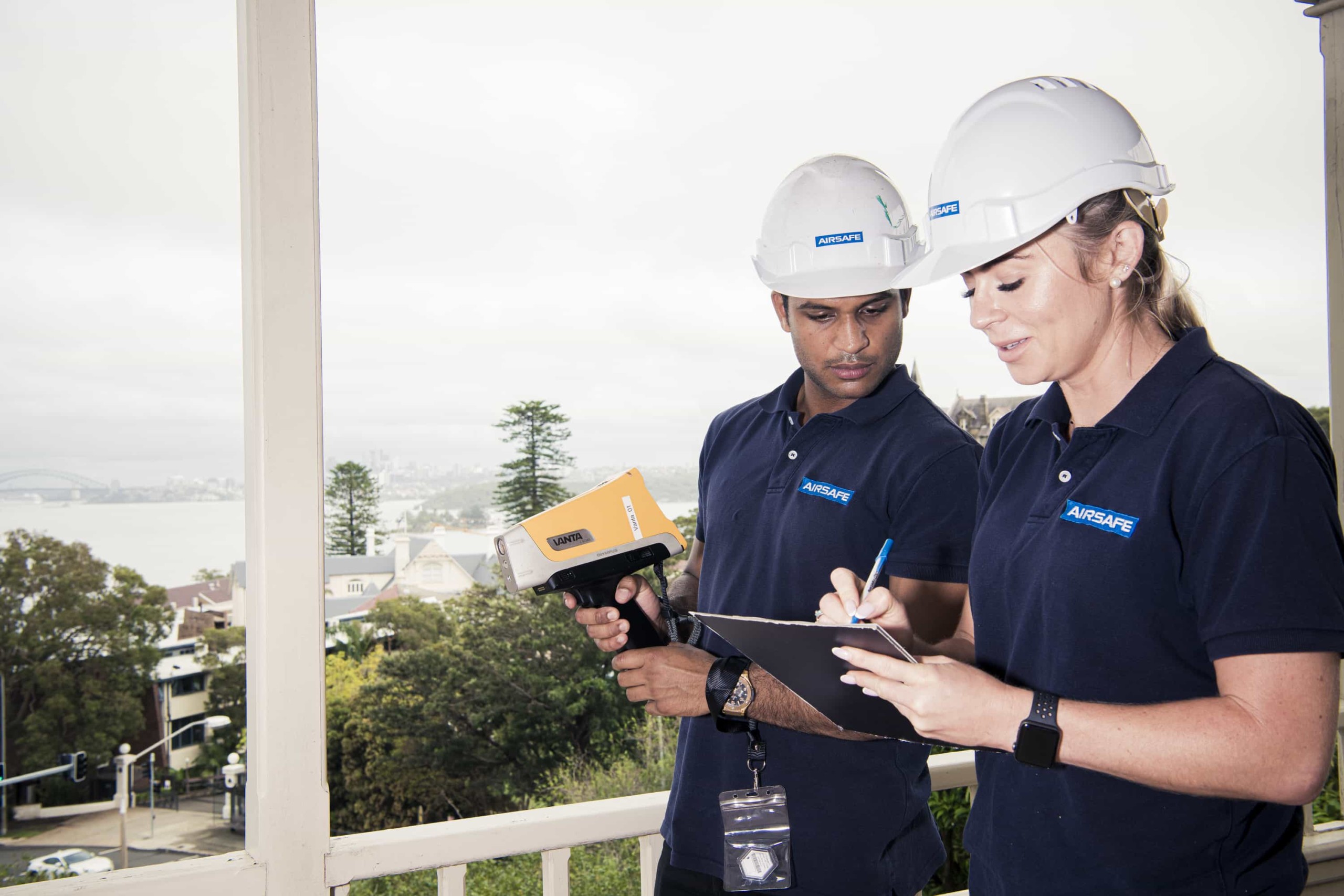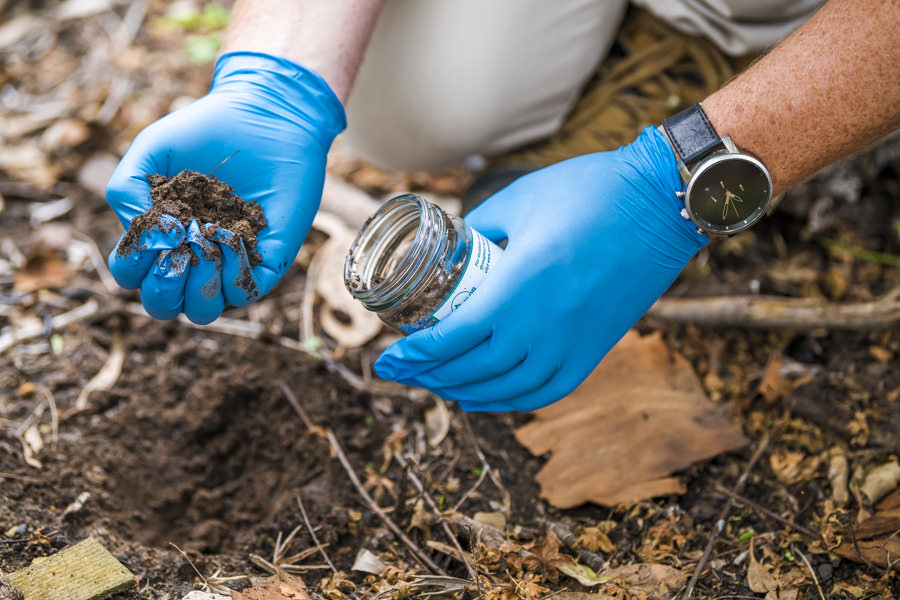If you suspect you’ve found lead or heavy metals in your workplace or home, whether, in paint, dust or soil, it’s important to get peace of mind fast.
Airsafe is here to help. For over 30 years, we’ve been helping residents and companies in Sydney and NSW identify and deal with hazardous materials like lead. Our rigorous quality systems mean we meet all government requirements around lead testing, so you can relax in the knowledge that our testing is 100% accurate.
How to collect and package your lead or heavy metal sample
How we test for lead: XRF analysers
Our state-of-the-art lead testing equipment includes two Olympus Vanta XRF analysers. XRF (X-ray fluorescence) is a non-destructive analytical technique used to determine the elemental composition of materials. XRF analysers determine the chemistry of a sample by measuring the fluorescent (or secondary) X-ray emitted from a sample when it is excited by a primary X-ray source.
XRF analysers can quantify or qualify practically every material on earth. With handheld XRF analysers, you have the option of taking the instrument into just about any location the unit will fit into. This gives us great flexibility in how we test for lead, because we don’t have to collect a sample for off-site laboratory testing. On-site testing via XRF is non-destructive, saves time and allows us to test a greater volume of product.
XRF is also invaluable in remedial works. Along with a visual inspection, it means we can ensure the removal area has been adequately cleaned prior to removal of containment zones.
Airsafe is now NATA Accredited for Lead Paint Testing
AIRSAFE is the first laboratory in Australia to become NATA accredited to perform paint analysis for elevated levels of lead using our Portable XRF analysis and our validated in-house method.
NATA accreditation provides that confidence. Being a NATA accredited facility builds credibility in an organisation’s products and services. Overall, accreditation creates confidence by providing a structured and reliable framework for the quality of results ensuring their traceability, comparability and validity. Our scope of accreditation can be found here.
Our XRF analysers are calibrated to test for:
- lead paint and lead in dust in accordance with the AS/NZS 4361.2:2017 Guide to Hazardous Paint Management Part 2: Lead Paint in residential, public and commercial buildings
heavy metals in soils in accordance with the NEPM: National Environment Protection (Assessment of Site Contamination) Measure.
Airsafe also has certified reference samples — that is, certified reference materials for paint and bulk samples to validate each method against objective standards. A certified reference material is a particular form of measurement standard. Since most analytical instrumentation is comparative, it requires a sample of known composition (reference material) for accurate calibration.
Our lead testing reports are NATA endorsed and compliant with ISO/IEC 17025 General requirements for the competence of testing and calibration laboratories.

Lead paint: your old hazardous materials surveys may be out of date
Lead paint (also known as lead-based paint, leaded paint, lead-containing paint and paint containing lead) is defined in Australian standards as paint containing more than 0.1% lead by mass.
All paint manufactured since 1997 contains less than 0.1% lead, but paints manufactured earlier often have lead in higher concentrations.
Until recently, the allowable concentration of lead in paint was 1%. However, the relevant standards were updated in 2017 (see the Guide to hazardous paint management, Part 1 and Part 2.)
These changes mean that old hazardous materials surveys are out of date. Paint that was previously deemed lead-free could now be deemed lead-containing, if the concentration of lead is between 0.1% and 1%.
-
Lead paint presents a risk to health if it is ingested or inhaled. There is minimal risk if the condition of the paint is sound, but it can become risky when it chalks or flakes, or in places like sash windows where it is subject to frequent abrasion.
Dust from deteriorated lead paint is a recognized source of lead exposure in residential, public and commercial buildings. The peeling and flaking of lead paint may also cause dangerous residues of lead to build up in accumulated dust.
As well as depositing inside buildings, lead paint dust can settle on adjacent external soil, water, food and vegetation. Therefore, food-producing gardens, or water supplies for human or animal consumption, should not be positioned near areas of possible lead contamination.
Lead paint also presents a health risk if is disturbed by paint removal methods like sanding or burning. Even mechanical scraping of lead paint poses health risks. In fact, removing paint can be especially risky, as small particles of dust may lodge in furnishings and carpets, making detection or removal difficult.
Proposed work sites may already be contaminated with lead due to earlier, poorly controlled maintenance or repainting practices. It may be necessary to determine background levels in surrounding soil, or on interior and exterior surfaces, prior to work commencing.

-
The power to control pollution caused by lead hazards is given to councils under the Protection of the Environment Operations Act 1997. Prevention notices with required actions can be issued if a council reasonably suspects that any activity has been or is being carried on in an environmentally unsatisfactory manner.
The Work Health and Safety Regulation 2017 contains the following clauses, which can carry penalties if not carried out.
- “A person conducting a business or undertaking at a workplace must assess each lead process carried out by the business or undertaking at the workplace to determine if lead risk work is carried out in the process.”
- “A person conducting a business or undertaking at a workplace must ensure, so far as is reasonably practicable, that contamination by lead is confined to a lead process area at the workplace.”
- A person conducting a business or undertaking at a workplace must ensure that any measures implemented to control health risks from exposure to lead at the workplace are reviewed and as necessary revised.”
-
Lead deposits are often found as dust in ceiling spaces, or in soil. Lead in dust or soil is often there as a result of previous refurbishment, but it can also be due to:
- Atmospheric deposits (e.g. from previous lead petrol use)
- Lead residue from nearby industrial sites (e.g. smelters)
- Other lead paint removal projects nearby.
If you suspect you may have found lead in dust or soil, it’s important to have a sample tested straight away.
Find out how to collect a dust or soil sample for lead testing
Criteria for lead dust levels have not been established in Australia. Lead dust levels are typically compared to health investigation levels for soil contaminants as stated in the National Environment Protection (Assessment of Site Contamination) Measure 1999 (April 2013).

-
The two primary means of lead contamination in humans are breathing in dust or fumes that contain lead, and swallowing food or water that contains lead. High lead levels can cause serious long-term health problems and harm almost every part of the body, especially the brain, kidneys and reproductive organs. Lead can damage the developing brain and nervous systems of unborn children much more easily than those of adults.
Children and adults with increased levels of lead in their bodies may show no symptoms, even though their health is being affected. When symptoms do become obvious, they include lethargy, stomach pain or constipation, headaches and irritability. Children show these symptoms at lower levels of exposure than adults do.
Contact us for lead testing today
Don’t risk your health and the health of others. Airsafe is here to ensure your space is safe with commercial and residential lead testing services. To get our expert help, call us on 1300 888 338.




